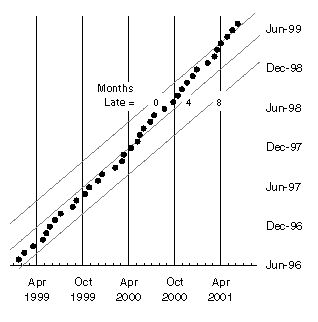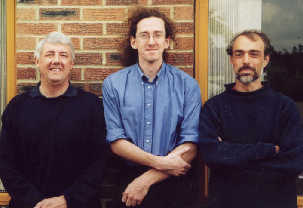|
With these jobs substantially completed, the ISC
development team is focusing on programs to automatically process data
in the relational database. The new programs will be able to take
advantage of data that cannot be accommodated in the files used by the
old programs. Some processing will be done soon after insertion in
the database so that the results can be made available as a
preliminary bulletin on the Internet.
Standardising Comment Formats
Some types of data previously saved as character
strings are stored in the database numerically. These can be
formatted for easier use in the CD data files and the on-line
Bulletin. Intensities are now formatted consistently regardless of
the source, for example, making it easier to compare damage reports
from different agencies.
Grouping Hypocentres
Each time a hypocentre is received and inserted in
the database a triggered procedure searches for hypocentres already in
the database that are close in time and space to the new one. If such
hypocentres are found then the new one is grouped with them in the
same ISC event. Previously, hypocentre grouping was carried out just
before ISC analysis, at least 22 months after the earthquakes
occurred.
The ease of repeatedly selecting hypocentres from
the database with different time and location criteria has made it
feasible to implement a more sophisticated grouping algorithm. The
improvement on the once-through algorithm used previously is
especially important for closely spaced earthquakes, such as
aftershocks, where an initial grouping hypothesis is most likely to be
in error. In the first month analysed after hypocentres were grouped
in the database, ISC editors manually moved only half as many
hypocentres between events as in previous months.
Identifying Duplicate Phases
Duplicate readings recognised in the database are
deprecated currently only if they are identical, i.e. the same
readings made by the same agency. Such duplicates may be sent to the
ISC either by the recording agency or via a third party. Promptly
identified duplicates will be hidden from ISC web site users,
simplifying the results of their queries.
There are also near-duplicates, readings that
differ only slightly, which may represent two agencies' picks from the
same time series or one agency's repeated measurements for the same
event. Approximate duplicates are recognised and recorded in the
database to guarantee that both are associated with the same event,
which ensures that ISC editors will spot them.
Currently, the database algorithm does not
deprecate near-duplicates, but leaves the editors to decide which to
use in the Bulletin. In the future, however, we plan further
development that will let the editors to accept or override
preferences between near-duplicates.
Automatic Association Based on Reports
Associating phase arrivals with hypocentres is one
of the ISC's most important jobs, partly because even users who
re-compute hypocentres rarely re-associate arrivals with different
events. Association has become more challenging as more agencies
report regional and local arrivals along with teleseismic phases.
But comprehensive reporting also helps to address
this challenge, since more agencies now report locally-determined
associations. For earthquakes from 1999 July, the ISC's processing
has been modified to use reported associations, and to seek the
best-fitting event only for readings with no reported
associations.
As a test, the modified system was used to
re-determine associations for readings from a month that had already
been analysed at the ISC. Associations were reported for 77% of the
81,000 readings in the 1999 January Bulletin. These reported
associations differed from those in the Bulletin only 0.6% of the
time, while ISC seismologists have typically changed 3% to 4% of the
associations that fit "best" according to the algorithm used at the
ISC since last year.
The test also revealed that associations with
events in the Bulletin were reported for more than 2000 further
readings. It is likely that ISC editors would have confirmed many of
these associations if they had been included in initial processing.
Thus, by making full use of reported associations, the new software
will make the Bulletin more complete as well as quicker to edit.
|



